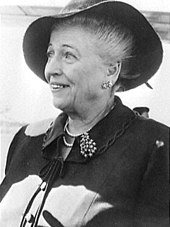Amerasian
[1][2] Several countries in East and Southeast Asia have significant populations of Amerasians, reflecting a history of US military presence within those two respective regions.
These include Okinawa (Japan), South Korea, Cambodia, China, Laos, Thailand, Vietnam, Taiwan and the Philippines.
[3][4] The term was coined by novelist Pearl S. Buck and was formalized by the Immigration and Naturalization Service.
The official definition of Amerasian came about as a result of Public Law 97-359, enacted by the 97th Congress of the United States on October 22, 1982.
"[7] The term is commonly applied to half Japanese children fathered by a U.S. serviceman based in Japan, as well as half Korean children fathered by veterans of the Korean War or stationary soldiers in South Korea.
Amerasian should not be interpreted as a fixed racial term relating to a specific category of multiracial groups (such as Mestizo, Mulatto, Eurasian or Afro-Asians).
[a][10] In the latter case, it is conceivable that the Amerasian could be fathered by a person who shares the same racial stock, but not necessarily the same nationality.
With genetic relation to U.S. soldiers, Amerasians have faced additional exclusion by perceived association to being military enemies of East and Southeast Asian countries.
Some contemporary writers had however reported rumors of 200,000 while actual numbers had been found to be 5,000, possibly 10,000, no more than 20,000 allowing for underestimates.
Since 1898, when the United States annexed the Philippines from Spain, there were as many as 21 U.S. bases and 100,000 U.S. military personnel stationed there.
[25][26] The newer Amerasians from the United States would add to the already older settlement of peoples from other countries in the Americas that happened when the Philippines was under Spanish rule.
The findings cited cases of racial, gender and class discrimination that Amerasian children and youth suffer from strangers, peers, classmates and teachers.
The study also said black Amerasians seem to suffer more from racial and class discrimination than their white-descended counterparts.
The women in these Camptowns were affected by the post-war poverty and turned to prostitution with American soldiers.
United States Congress passed the 1953 Refugee Relief Act which allowed 4000 Amerasians to emigrate to the US for adoption.
[36] US soldiers fathered children in Taiwan at the end of World War II.
[37] Over 200,000 American soldiers in Korea and Vietnam visited Taiwan for rest and relaxation between 1950 and 1975.
I was teased and bullied a lot because of my skin color," says entertainer Morris Kple Roberts, who had an African American father and a Thai mother.
[42] US veteran, Gene Ponce, helps American fathers find their Thai Amerasian children.
He has recently used popular DNA services, such as Ancestry.com to help match Amerasians with their relatives in the US.
[49] In July 1979, the United Nations High Commissioner for Refugees (UNHCR) created the Orderly Departure Program in order to mitigate safer travel conditions for Vietnamese refugees to various nations after the Vietnam War.
[55][56][57][58][59] Other organizations that helped with Amerasian, Adoptee and family searches included the Adopted Vietnamese International (AVI) (Indigo Willing) and Operation Reunite (Trista Goldberg).





